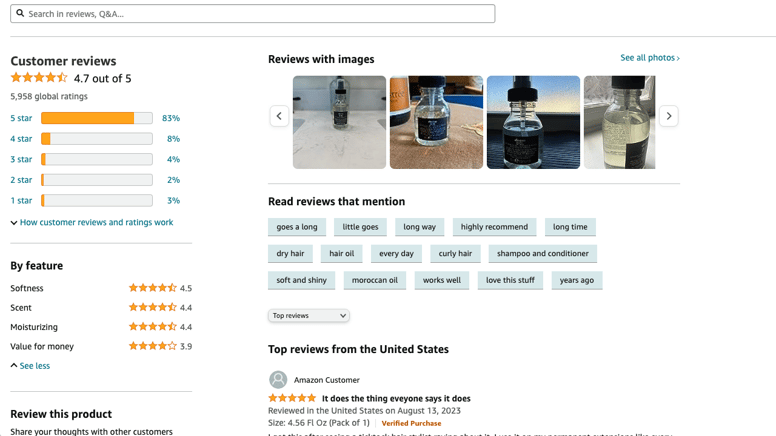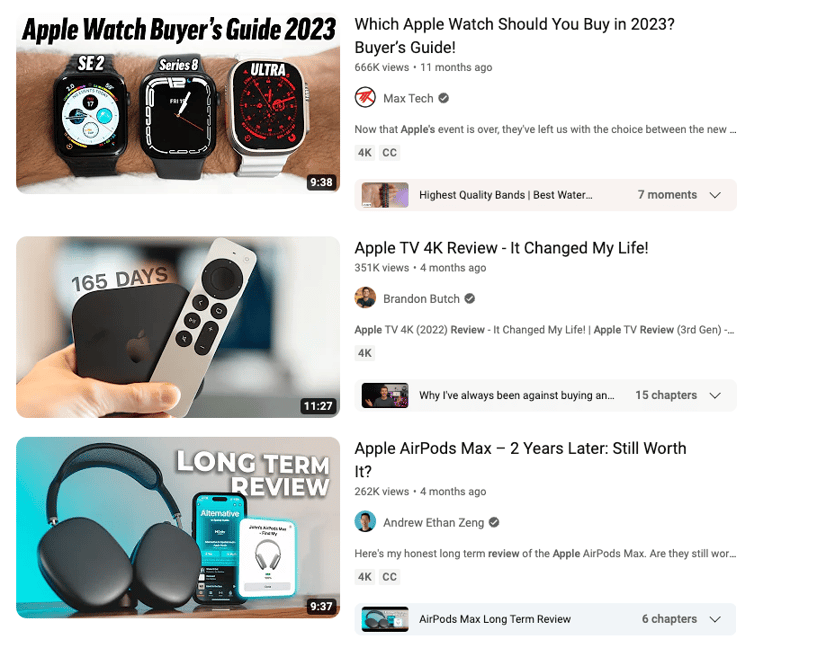Customer Segmentation and Persona Development
For some marketing teams, segmentation is seen as a dirty word. Brand managers may see their product or service as having universal appeal and may be...

Customer satisfaction is more than just a metric—it can be a valuable marketing tool.
While customer feedback has long served as as a guide for refining sales and service tactics, its influence extends much further. Showcasing customer reviews and stories in your marketing can improve brand allegiance, pave the way for converting potential customers, and can supercharge your SEO.
But how can marketers effectively utilize these reviews to improve the customer journey?
Customer reviews can play a role in enhancing the customer decision journey. As consumers become increasingly wary of advertising, reviews serve as beacons of authenticity and reliability.
In fact, 89% of consumers remain on the fence until they peruse reviews.
Customer reviews give potential buyers a real-life look at others' experiences, building trust and validation for a product or service.
Reviews address the uncertainties and doubts that naturally arise during the decision-making process. They provide context and depth, illustrating the product features, their real-world applications, benefits, and even limitations.
This insight helps customers set realistic expectations, lessening the risk of buyer's remorse.
And when businesses respond to reviews, especially negative ones, it shows they care about customers and want to build trust and loyalty.
Customer reviews help customers make better decisions by providing honest insights, building trust, and leading to informed purchases.
When the consumer journey is mostly or entirely digital, consumers typically cannot touch, feel, or directly experience a product before purchase.
In place of physical reassurance, customer reviews serve as a testament to a product's or service's quality and functionality.
They show what previous users experienced, helping potential buyers know what to expect.
An example of this is Patagonia's Worn to Wear Stories page which showcases customer adventures with the brand's gear while offering a glimpse into their diverse lives.
What makes this approach interesting is that it highlights durability of Patagonia products and the deep affection customers have for the brand, but it also solidifies Patagonia's core values and brand identity.

With a commitment to environmental conservation, Patagonia sets itself apart from more affordable alternatives by demonstrating their value through the experiences and expertise of their customers, emphasizing exceptional customer service and fostering genuine connections.
The customer reviews and stories presented resonate with the brand's values and unique culture.
While technology has made things more convenient, it has also introduced a level of detachment and potential distrust.
As an example, consider that a survey of financial services customers showed that only 30% of people who prefer physical bank branches actually go to one.
However, often, when we conducting surveys and focus groups with our financial services clients, we often discover that customers simply feel reassured knowing that there is a real person on the other side of the transaction.
This reassurance is present even if they don't ever actually interact with the person.
In our experience, customer stories help demonstrate the human side of a brand and its digital products and services.
Reading about someone's personal experience with a product is akin to getting advice from a peer. These reviews help bridge the gap between digital convenience and human trust.
Another example we're all familiar with is Amazon reviews, which are placed prominently on product pages.
This strategy vouches for the product's quality and brings forth diverse user experiences, giving potential buyers a comprehensive view.

In fact, the more balanced your reviews, the more trustworthy and human you appear. It might seem counterintuitive, but an occasional negative review isn't necessarily a bad thing.
96% of customers actively seek negative feedback to understand before committing because a perfect record tends to seem unbelievable.
Some brands, like Liquid Death, even thrive on negative feedback as a way to highlight who their core audience is not.

In 2023, Google made important changes to how consumer reviews affect search results.
In February, the Product Reviews Update prioritized insightful, comprehensive, and informative product reviews. This meant that reviews that focus on specific product features, benefits, drawbacks, and uses become more important.
But Google didn't stop there.
In April, they expanded its reviews system to include evaluations of services, media, and many other areas. This change meant brands across sectors, such as hospitality, entertainment, or dining, could leverage the power of positive feedback in search results.
The changes continued in May with the Local Reviews Update.
In this update, Google emphasized the depth and richness of content, specifically for local businesses, making it important to consider details such as location, operating hours, and the quality of service in reviews.
The message is clear for businesses aiming to improve visibility online: collect and display exceptional, in-depth customer reviews.
One way to do this is through review widgets which can seamlessly incorporate customer reviews onto key landing pages. This simple adjustment to your site can help enhance its performance in organic search results.
By displaying these reviews on your website, you not only improve the content, but also add relevant text that can boost your search rankings by providing Google with a better understanding of the page's importance and how it may rank for certain user searches.
Stellar reviews act as the modern word-of-mouth, converting satisfied clients into brand ambassadors. This offers businesses a cost-effective method of advertising, directly reaching potential customers.
A classic example is Apple. Their positive reviews from experts and regular users have created a loyal fan base. These fans support and defend the brand, often persuading others to purchase their products.

For brands that have the stomach for risk, negative reviews can also work.
One of the most notable examples of a company using negative reviews in their advertising is Domino's Pizza.
In the late 2000s, Domino's faced a slew of negative feedback about the taste and quality of their pizzas. Rather than sidestepping the issue, Domino's confronted it head-on with a bold advertising campaign called "The Pizza Turnaround."
Domino's openly displayed actual customer complaints, such as "Domino's pizza crust tastes like cardboard" and "microwave pizza is much better."
Domino's used these genuine critiques as an opportunity to communicate their commitment to improving.
The paid ads (which is why this section is titled "Free(ish)") showed how the company improved their pizza recipe. They filmed their chefs trying new ingredients and methods, and their commitment to making it perfect.
By using this transparent approach, Domino's was not only able to improve its product but also strengthen its relationship with customers.
The campaign was seen as a risk that worked, leading to more sales and a better brand image.
It showcased the company's humility, responsiveness, and commitment to quality, turning a potential PR crisis into a compelling brand narrative.
By weaving real-life testimonials into various marketing channels, businesses can captivate their audience and strengthen their campaigns' effectiveness. Here are a few more examples of how brands have included customer feedback into their marketing efforts.
Brands like Fabletics have strategically positioned customer reviews on their homepage, immediately establishing trust with site visitors.

Google's AdWords, for instance, allows advertisers to showcase their Google My Business reviews. This not only elevates the credibility of the ads but also improves the click-through rates.
Brands can repost positive testimonials on platforms like Instagram or Twitter. For instance, tech brands often share unboxing or review videos made by customers, giving a genuine perspective to potential buyers.

Considering the unparalleled ROI of email marketing, integrating positive reviews can significantly improve engagement. Brands like Calm, effectively incorporate customer testimonials in their email marketing to highlight the value their app provides.
Advertisements peppered with genuine user reviews tend to resonate better with potential customers. Trustpilot's data further validates this, revealing that consumers perceive ads accompanied by reviews as 88% more trustworthy.
Authentic customer reviews hold immense significance. Brands that actively integrate these reviews into their marketing strategies will likely see enhanced engagement, conversions, and, ultimately, increased revenue.
 By embracing customer reviews, businesses not only improve their products and services but also fortify their brand image. So, take the plunge, harness the power of reviews, and watch your bottom line soar.
By embracing customer reviews, businesses not only improve their products and services but also fortify their brand image. So, take the plunge, harness the power of reviews, and watch your bottom line soar.
Sign up for our monthly newsletter to receive updates.

For some marketing teams, segmentation is seen as a dirty word. Brand managers may see their product or service as having universal appeal and may be...

In marketing, we spend a lot of time trying to attract new customers, but it’s also important to know how many customers you may be losing. So, in...

Today, brands are more vulnerable than ever to social media trends that can rapidly influence consumer perception.